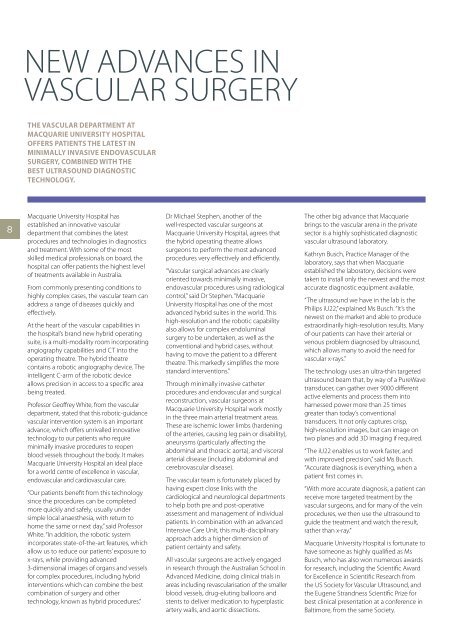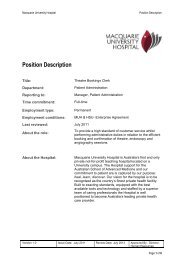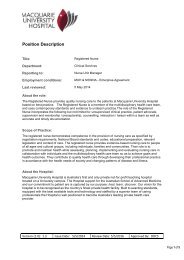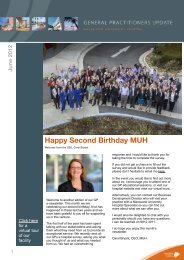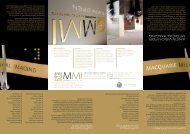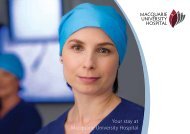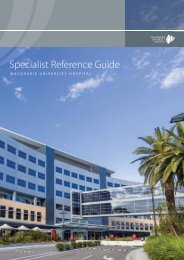reconstructive plastic surgery - Macquarie University Hospital
reconstructive plastic surgery - Macquarie University Hospital
reconstructive plastic surgery - Macquarie University Hospital
You also want an ePaper? Increase the reach of your titles
YUMPU automatically turns print PDFs into web optimized ePapers that Google loves.
8<br />
NeW ADVANCeS IN<br />
VASCUlAR SURGeRY<br />
THE VASCulAR DEPARTMEnT AT<br />
MACquARiE uniVERSiTY HOSPiTAl<br />
OffERS PATiEnTS THE lATEST in<br />
MiniMAllY inVASiVE EnDOVASCulAR<br />
SuRGERY, COMbinED wiTH THE<br />
bEST ulTRASOunD DiAGnOSTiC<br />
TECHnOlOGY.<br />
<strong>Macquarie</strong> <strong>University</strong> <strong>Hospital</strong> has<br />
established an innovative vascular<br />
department that combines the latest<br />
procedures and technologies in diagnostics<br />
and treatment. With some of the most<br />
skilled medical professionals on board, the<br />
hospital can offer patients the highest level<br />
of treatments available in Australia.<br />
From commonly presenting conditions to<br />
highly complex cases, the vascular team can<br />
address a range of diseases quickly and<br />
effectively.<br />
At the heart of the vascular capabilities in<br />
the hospital’s brand new hybrid operating<br />
suite, is a multi-modality room incorporating<br />
angiography capabilities and CT into the<br />
operating theatre. The hybrid theatre<br />
contains a robotic angiography device. The<br />
intelligent C-arm of the robotic device<br />
allows precision in access to a specific area<br />
being treated.<br />
Professor Geoffrey White, from the vascular<br />
department, stated that this robotic-guidance<br />
vascular intervention system is an important<br />
advance, which offers unrivalled innovative<br />
technology to our patients who require<br />
minimally invasive procedures to reopen<br />
blood vessels throughout the body. It makes<br />
<strong>Macquarie</strong> <strong>University</strong> <strong>Hospital</strong> an ideal place<br />
for a world centre of excellence in vascular,<br />
endovascular and cardiovascular care.<br />
“our patients benefit from this technology<br />
since the procedures can be completed<br />
more quickly and safely, usually under<br />
simple local anaesthesia, with return to<br />
home the same or next day,” said Professor<br />
White. “In addition, the robotic system<br />
incorporates state-of-the-art features, which<br />
allow us to reduce our patients’ exposure to<br />
x-rays, while providing advanced<br />
3-dimensional images of organs and vessels<br />
for complex procedures, including hybrid<br />
interventions which can combine the best<br />
combination of <strong>surgery</strong> and other<br />
technology, known as hybrid procedures.”<br />
Dr Michael Stephen, another of the<br />
well-respected vascular surgeons at<br />
<strong>Macquarie</strong> <strong>University</strong> <strong>Hospital</strong>, agrees that<br />
the hybrid operating theatre allows<br />
surgeons to perform the most advanced<br />
procedures very effectively and efficiently.<br />
“Vascular surgical advances are clearly<br />
oriented towards minimally invasive,<br />
endovascular procedures using radiological<br />
control,” said Dr Stephen. “<strong>Macquarie</strong><br />
<strong>University</strong> <strong>Hospital</strong> has one of the most<br />
advanced hybrid suites in the world. This<br />
high-resolution and the robotic capability<br />
also allows for complex endoluminal<br />
<strong>surgery</strong> to be undertaken, as well as the<br />
conventional and hybrid cases, without<br />
having to move the patient to a different<br />
theatre. This markedly simplifies the more<br />
standard interventions.”<br />
Through minimally invasive catheter<br />
procedures and endovascular and surgical<br />
reconstruction, vascular surgeons at<br />
<strong>Macquarie</strong> <strong>University</strong> <strong>Hospital</strong> work mostly<br />
in the three main arterial treatment areas.<br />
These are ischemic lower limbs (hardening<br />
of the arteries, causing leg pain or disability),<br />
aneurysms (particularly affecting the<br />
abdominal and thoracic aorta), and visceral<br />
arterial disease (including abdominal and<br />
cerebrovascular disease).<br />
The vascular team is fortunately placed by<br />
having expert close links with the<br />
cardiological and neurological departments<br />
to help both pre and post-operative<br />
assessment and management of individual<br />
patients. In combination with an advanced<br />
Intensive Care Unit, this multi-disciplinary<br />
approach adds a higher dimension of<br />
patient certainty and safety.<br />
All vascular surgeons are actively engaged<br />
in research through the Australian School in<br />
Advanced Medicine, doing clinical trials in<br />
areas including revascularisation of the smaller<br />
blood vessels, drug-eluting balloons and<br />
stents to deliver medication to hyper<strong>plastic</strong><br />
artery walls, and aortic dissections.<br />
The other big advance that <strong>Macquarie</strong><br />
brings to the vascular arena in the private<br />
sector is a highly sophisticated diagnostic<br />
vascular ultrasound laboratory.<br />
Kathryn Busch, Practice Manager of the<br />
laboratory, says that when <strong>Macquarie</strong><br />
established the laboratory, decisions were<br />
taken to install only the newest and the most<br />
accurate diagnostic equipment available.<br />
“The ultrasound we have in the lab is the<br />
Philips iU22,” explained Ms Busch. “It’s the<br />
newest on the market and able to produce<br />
extraordinarily high-resolution results. Many<br />
of our patients can have their arterial or<br />
venous problem diagnosed by ultrasound,<br />
which allows many to avoid the need for<br />
vascular x-rays.”<br />
The technology uses an ultra-thin targeted<br />
ultrasound beam that, by way of a PureWave<br />
transducer, can gather over 9000 different<br />
active elements and process them into<br />
harnessed power more than 25 times<br />
greater than today’s conventional<br />
transducers. It not only captures crisp,<br />
high-resolution images, but can image on<br />
two planes and add 3D imaging if required.<br />
“The iU22 enables us to work faster, and<br />
with improved precision,” said Ms Busch.<br />
“Accurate diagnosis is everything, when a<br />
patient first comes in.<br />
“With more accurate diagnosis, a patient can<br />
receive more targeted treatment by the<br />
vascular surgeons, and for many of the vein<br />
procedures, we then use the ultrasound to<br />
guide the treatment and watch the result,<br />
rather than x-ray.”<br />
<strong>Macquarie</strong> <strong>University</strong> <strong>Hospital</strong> is fortunate to<br />
have someone as highly qualified as Ms<br />
Busch, who has also won numerous awards<br />
for research, including the Scientific Award<br />
for excellence in Scientific Research from<br />
the US Society for Vascular Ultrasound, and<br />
the eugene Strandness Scientific Prize for<br />
best clinical presentation at a conference in<br />
Baltimore, from the same Society.


